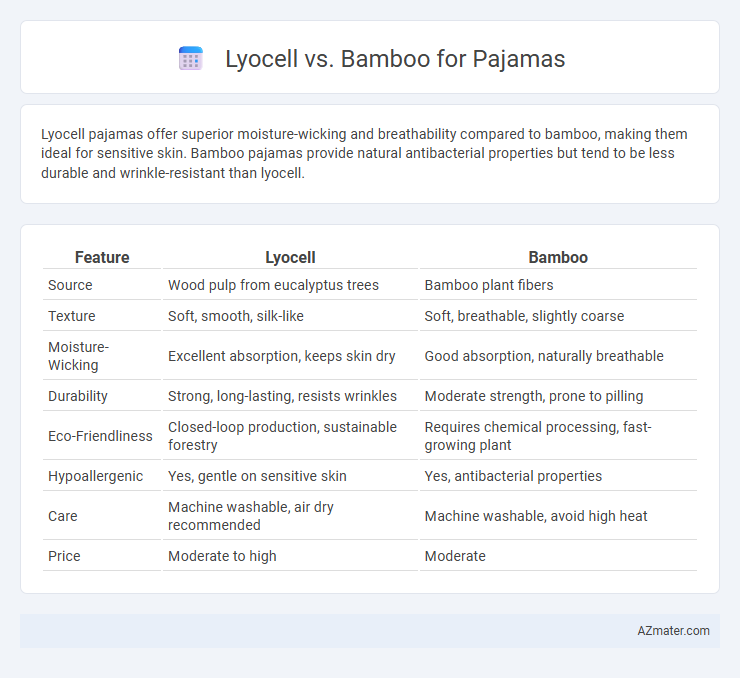Lyocell pajamas offer superior moisture-wicking and breathability compared to bamboo, making them ideal for sensitive skin. Bamboo pajamas provide natural antibacterial properties but tend to be less durable and wrinkle-resistant than lyocell.
Table of Comparison
| Feature | Lyocell | Bamboo |
|---|---|---|
| Source | Wood pulp from eucalyptus trees | Bamboo plant fibers |
| Texture | Soft, smooth, silk-like | Soft, breathable, slightly coarse |
| Moisture-Wicking | Excellent absorption, keeps skin dry | Good absorption, naturally breathable |
| Durability | Strong, long-lasting, resists wrinkles | Moderate strength, prone to pilling |
| Eco-Friendliness | Closed-loop production, sustainable forestry | Requires chemical processing, fast-growing plant |
| Hypoallergenic | Yes, gentle on sensitive skin | Yes, antibacterial properties |
| Care | Machine washable, air dry recommended | Machine washable, avoid high heat |
| Price | Moderate to high | Moderate |
Introduction to Lyocell and Bamboo Fabrics
Lyocell, a sustainable fabric derived from wood pulp, is known for its softness, breathability, and moisture-wicking properties, making it ideal for comfortable pajamas. Bamboo fabric, produced from bamboo fibers, offers natural antibacterial qualities, excellent breathability, and thermal regulation, enhancing nighttime comfort. Both fabrics are eco-friendly alternatives to traditional materials, appealing to consumers seeking sustainable and luxurious sleepwear options.
Fiber Sources: What are Lyocell and Bamboo Made From?
Lyocell fibers are derived from sustainably sourced wood pulp, primarily eucalyptus, beech, and spruce trees, processed using an eco-friendly closed-loop method that recycles solvents. Bamboo fibers used in pajamas come from the bamboo plant, but most bamboo textiles are actually bamboo viscose or rayon made by chemically breaking down bamboo pulp, which can impact environmental benefits. Lyocell's production emphasizes sustainability and minimal chemical use, whereas bamboo fibers often involve more intensive chemical treatments despite the renewable nature of bamboo as a fast-growing plant.
Production Processes Compared
Lyocell production involves a closed-loop process that uses non-toxic solvents to dissolve wood pulp, primarily sourced from eucalyptus trees, resulting in minimal environmental impact and high fiber purity. Bamboo fabric production typically requires chemical-intensive processes such as the viscose method, which uses harsh chemicals like sodium hydroxide and carbon disulfide, raising environmental and health concerns due to toxic waste generation. The eco-friendly and efficient production of lyocell makes it a more sustainable option for pajamas compared to conventional bamboo viscose manufacturing.
Environmental Impact of Lyocell vs Bamboo
Lyocell pajamas are produced using a closed-loop process that recycles water and solvents, significantly reducing environmental pollution compared to traditional methods. Bamboo fabric production typically involves chemical-intensive processes unless it is mechanically processed into bamboo linen, which is less common and more costly. Lyocell's sustainable manufacturing and biodegradability make it a more eco-friendly choice compared to conventional bamboo textiles with higher chemical usage and water impact.
Comfort and Feel: Which is Softer?
Lyocell pajamas offer a silky-smooth texture with excellent breathability, making them exceptionally soft and comfortable against the skin. Bamboo fabric is naturally hypoallergenic and moisture-wicking, providing a buttery softness that enhances comfort, especially for sensitive skin. While both fabrics are soft, Lyocell tends to have a cooler, more luxurious feel, whereas bamboo delivers a cozy, plush softness that adapts well to different temperatures.
Breathability and Moisture Wicking Properties
Lyocell pajamas offer superior breathability due to their semi-synthetic fiber structure, allowing better air circulation and cooling effects during sleep. Bamboo fabric excels in moisture-wicking because of its natural micro-gaps, which efficiently draw sweat away from the skin to keep the wearer dry. Both materials provide comfort, but Lyocell tends to be more breathable while bamboo stands out for effective moisture management.
Durability and Longevity
Lyocell pajamas are known for their exceptional durability, maintaining softness and strength even after multiple washes due to their tightly woven fibers and resistance to wear. Bamboo fabric offers natural antimicrobial properties and breathability but tends to weaken more quickly under frequent washing compared to Lyocell. For long-lasting pajamas, Lyocell provides superior longevity and resilience, making it a more durable choice.
Skin Friendliness and Hypoallergenic Qualities
Lyocell fibers, derived from sustainably sourced eucalyptus wood, offer exceptional skin friendliness due to their smooth texture and natural moisture-wicking properties, making them ideal for sensitive skin. Bamboo fabric, known for its inherent antibacterial and hypoallergenic qualities, reduces irritation and supports healthier skin by minimizing allergen accumulation. Both materials provide breathable, soft comfort, but Lyocell's superior moisture management and bamboo's natural antimicrobial properties uniquely enhance hypoallergenic pajama options.
Price and Availability for Pajamas
Lyocell pajamas typically have a higher price point due to the sustainable production process and limited manufacturing facilities, whereas bamboo pajamas are generally more affordable and widely available because bamboo fibers are easier to source and produce at scale. Availability of bamboo pajamas is more consistent across various retailers, including online marketplaces and specialty stores, while Lyocell pajamas might be found primarily in eco-friendly or premium brands with selective distribution. Consumers seeking budget-friendly options often prefer bamboo pajamas, while those prioritizing sustainable luxury may opt for Lyocell despite its higher cost.
Which is Better for Pajamas: Lyocell or Bamboo?
Lyocell offers superior moisture-wicking and breathability compared to bamboo, making it ideal for pajamas that require comfort during warm nights. Bamboo fabric is naturally antibacterial and hypoallergenic, providing a gentle option for sensitive skin but tends to retain more moisture. Lyocell's durability and smooth texture often outperform bamboo in long-lasting softness and wrinkle resistance, positioning it as a better overall choice for high-quality sleepwear.

Infographic: Lyocell vs Bamboo for Pajama
 azmater.com
azmater.com